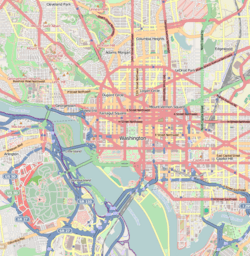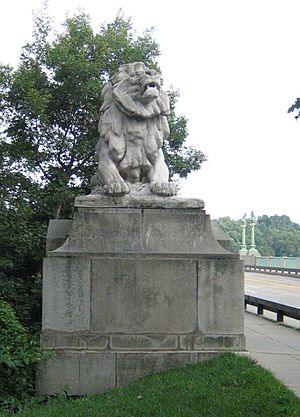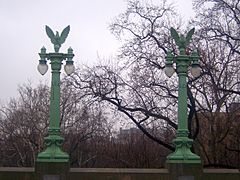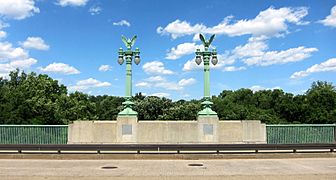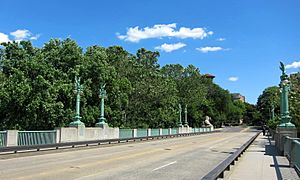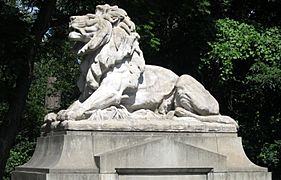Taft Bridge facts for kids
Quick facts for kids Taft Bridge |
|
|---|---|
| Characteristics | |
| Total length | 901 feet (275 m) |
|
William Howard Taft Bridge
|
|
 |
|
| Location | Connecticut Avenue, NW over Rock Creek Washington, D.C. |
|---|---|
| Built | 1906 |
| Architect | Edward Pearce Casey |
| Engineer | George S. Morison |
| Architectural style | Classical Revival |
| NRHP reference No. | 03000584 |
| Added to NRHP | July 3, 2003 |
The Taft Bridge is a famous bridge in Washington, D.C.. It is also known as the Connecticut Avenue Bridge or the William Howard Taft Bridge. This historic bridge crosses the deep Rock Creek gorge, carrying Connecticut Avenue over Rock Creek and the Rock Creek and Potomac Parkway. It connects the neighborhoods of Woodley Park and Kalorama. The bridge is named after William Howard Taft, who was a U.S. President and a Supreme Court Chief Justice. It is located southwest of the Duke Ellington Bridge.
Four large lion statues, called the Perry Lions, stand guard at both ends of the bridge. These impressive sculptures were made by Roland Hinton Perry. The Taft Bridge was added to the National Register of Historic Places on July 3, 2003, recognizing its importance.
Building the Taft Bridge
The Taft Bridge was built between 1897 and 1907. It was designed in a style called Classical Revival, which means it looks like ancient Greek and Roman buildings. The main engineer for the project was George S. Morison, and the architect was Edward Pearce Casey.
This bridge is an arch bridge, meaning it uses strong arches to support its weight. It was built using a special type of concrete. The arches are made of "unreinforced concrete," which means it doesn't have steel bars inside to make it stronger. The top part of the bridge, where cars drive, is made of "reinforced concrete," which does have steel inside. The bridge is about 274.5 meters (901 feet) long. People have called it an "engineering marvel" because it was one of the largest unreinforced concrete structures in the world when it was built.
In 1931, the bridge was officially named after William Howard Taft. He often walked across the bridge when he was the Chief Justice of the United States. Later, in the 1960s, there were plans for the Washington Metro (the city's subway system) to run across the bridge. However, the subway line was eventually built underground instead.
The Perry Lions
The Taft Bridge is famous for the four large lion statues that seem to "guard" it. There are two lions at each end of the bridge. Each lion is very big, about 2.1 meters (7 feet) tall and 3.9 meters (13 feet) long. Two of the lions are shown resting on all fours, looking up with their mouths slightly open. The other two are lying down with their eyes closed, looking like they are sleeping.
These lions were designed and sculpted by Roland Hinton Perry in 1906. They were made from "cast concrete," which is concrete poured into a mold. The lions were put on the bridge in 1907. The Taft Bridge itself was one of the first bridges in the country to be built using cast concrete.
Over the years, the lions needed repairs. In 1964, a sculptor named Renato Luccetti tried to fix them and protect them from the weather. But his work didn't last forever. By 1993, when the bridge was getting a big repair, the lions were in very bad shape. They had to be taken off the bridge for more restoration.
Sadly, the original sculptures were too damaged to be fully restored. So, in the late 1990s, new lions were made. A sculptor named Reinaldo Lopez-Carrizo made new molds from the old lions and old photos. He then used these molds to create brand new concrete lion sculptures. These new lions were placed on the bridge in July and August of 2000. The same molds were also used to make bronze lions for the main entrance of the National Zoo in 2002.
Eagle Lampposts
Along both sides of the Taft Bridge, there are 24 unique lampposts. These lampposts were created by sculptor Ernest Bairstow in 1906. Each lamppost has a concrete base that is about 1.5 meters (5 feet) tall. On top of the base is a tall, painted iron lamppost, about 5.2 meters (17 feet) high.
The concrete bases are decorated with designs like garlands and acanthus leaves. Above the leaves, there's a horizontal bar with two globes (like light bulbs) hanging from each side. The most striking part is at the very top: each lamppost is crowned with a painted iron eagle with its wings spread wide, as if ready to fly.
A copy of one of these Bairstow eagles can also be seen on a World War I monument in Middletown, Delaware.
Gallery


